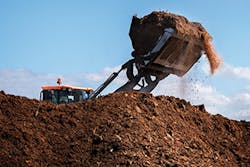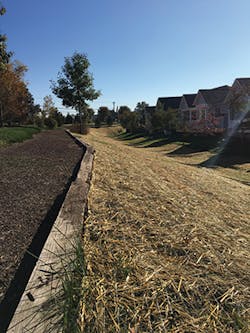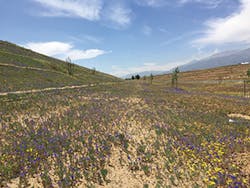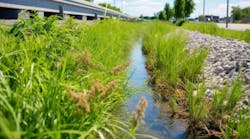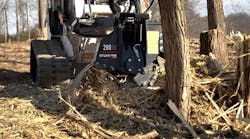Construction can lead to depleted soils because of the time that soil stays piled up on a site. Some soils are not good to start with because of lack of organic matter or nutrients. Others have poor texture, such as very sandy or heavy clay, which will not easily support vegetation. If your project involves using vegetation for erosion control or for aesthetics, you need to find a way to improve the soil. Trucking in new topsoil is very expensive. It is better—in regards to both time and cost—to improve the soil that is present.
To accomplish that task, you’ll most likely need soil amendments. These materials can include compost, manufactured soil enhancers, fertilizers, and nutrients. They can be applied in different ways. Some of these considerations will depend on what the soil needs and on the size and accessibility of the site.
Once decisions are made on how to get the soil in better shape, you must choose the right seed. Many governmental agencies require native seed for the final stand of vegetation. You might also need a quick-growing species, which might not be a native, to anchor the soil while permanent vegetation grows in.
Know About Compost
Compost use is increasing in the erosion control world. But it’s important to know where the compost is sourced. Compost can be contaminated if painted or treated wood is used or if the material in the compost has been treated with herbicide. These contaminants can destroy the chances of a good stand of vegetation, regardless of any benefit from the organic matter. Results of contaminated compost can include poor germination rates and sparse growth.
Municipalities can benefit from the increasing use of compost because the compost can be made from greenwaste. That reduces the volume of waste to be handled by solid waste facilities.
The US Composting Council advocates for compost manufacturers and use of compost, as well as recycling as a matter of routine. In 2000, the Council set up a program to establish a standard of compost sourcing and labeling. The Council’s Seal of Testing Assurance (STA) program shows that the compost has been manufactured in compliant facilities and has been tested. The Council’s publication, Test Methods for the Examination of Composting and Compost, describes the physical, chemical, and biological tests a facility should perform on compost. The test results allow purchasers to compare compost products and determine which compost is best for their planned use. Having the STA on a product provides assurance that it does not contain the contaminants of painted or treated wood, herbicides, or heavy metals.
Compost manufacturers that participate in the STA program must certify that they are in compliance with all local, state, and federal regulations on compost. They have to provide a testing regimen and follow specified testing procedures and reporting.
The US Composting Council provides members with information about compost and its benefits. Compost is made up of the decomposition of biodegradable matter that has been sanitized by the generation of heat and stabilized to provide benefit to plant growth. It provides organic material needed by all vegetation. It contains plant nutrients, but is not classified as fertilizer.
Compost benefits plant growth by:
- Improving soil structure, porosity, and density, making root growth more likely
- Increasing infiltration and reducing erosion and runoff
- Cushioning the hit of raindrops
- Improving water retention, making it available for germination and growth
- Supplying a mixture of macro- and micronutrients
- Improving the cation exchange capacity of soil, providing better nutrient availability
- Providing important organic matter for plant growth
- Supplying microorganisms
- Stabilizing soil pH
- Providing drought resistance
- Suppressing some plant diseases
- Binding and degrading some pollutants
Residential development common area
Compost can be spread and incorporated into soil or it can be applied as a compost blanket. The blanket is a layer of loosely applied composted material. Compost blankets are applied with pneumatic blower trucks, using air rather than water as hydromulchers do. Seed can also be in the applied mixture.
The Federal Highway Administration supported specifications for compost used in erosion control. The Recycled Materials Resource Center at the University of New Hampshire, the US Composting Council, and the American Association of State Highway and Transportation Officials (AASHTO) compiled criteria for compost products and the testing that is required. The parameters that must be met include soluble salt concentration, moisture and organic material content, particle size, stability, carbon dioxide evolution rate, and physical contaminants. The document also lists application rates and dimensions of compost berms.
Compost Tips
Britt Faucette, director of research, technical, and environmental services with Filtrexx Sustainable Technologies, shares his expertise with compost products. Filtrexx invented the compost filter sock in 2001 and went on to manufacture several compost-based products, including compost blankets for erosion control.
The Filtrexx Compost Erosion Control Blanket is a compost medium that meets specific particle size and quality parameters. It can be used for temporary or permanent slope stabilization, erosion control, and establishment of vegetation. It must be applied so that there are no bare spots. The thickness must be a minimum of 1 inch to ensure complete coverage and a maximum of 2 inches. Any more than 2 inches might cause the seed to lose soil contact, and many plants cannot make it through 2 inches to sunlight.
Faucette lists some of the advantages of compost blankets:
- The organic material in compost blankets enhances the health of any type of soil.
- Compost buffers pH in soil, either acidic or basic levels.
- The compost blanket absorbs water and holds it, providing both erosion control and moisture for seed establishment.
- The product provides an excellent environment for seed growth.
- Application of compost blankets is a one-step process, saving time and labor costs.
- There is little or no need for fertilizers or other amendments.
He also mentions some of the limitations of compost blankets:
- Compost blankets for erosion control are not appropriate where concentrated flows occur because they do not have the strength to handle the flows.
- They are not a good choice for slopes greater than 1:1.
Compost blankets can be used in combination with Filtrexx SiltSoxx, placed as slope interrupters to slow water flow or at the bottom of a slope. Filtrexx LockDown Netting, an open-mesh netting, can be added on top of the soil to roughen the surface to better hold the compost in place and on top of the compost blanket in high-wind areas to help keep it in place.
Faucette predicts an increase in the use of these products over the next few years. He says that 10 to 15 years ago, research showed the value of compost and federal and state agencies began including it in specifications for projects. Since that time, more projects have used compost and that likely will continue and expand.
The following case studies show how others are using compost products and other soil enhancements. The information can give you options and help you decide what would fit for your next project.
After restoration
Pennsylvania Development
A developer in Pennsylvania was struggling to get vegetation established on sloped parts of a common area behind new homes. The lack of vegetation was allowing erosion to bring sediment down to the houses. A trail wound around behind the houses with more slopes above that. The entire area needed help and quickly; the developer wanted to establish turf to stop soil washing down toward the new houses.
The soil was tested and found to be clay based and therefore prone to compaction. It also was low in organic matter. WeCare Organics supplied WeCare Compost from its Burlington County, NJ, composting facility. The compost is a class A EQ biosolids compost that is STA certified through the US Composting Council. It is screened ⅜ inch minus, giving a fine-textured compost.
WeCare Organics began in the 1990s as an organics and residuals management company. In 2016, it merged with Denali Water Solutions. The company has established compost operations and facilities through the Northeast.
WeCare Compost can supply important levels of organic matter, which will improve soil structure, porosity, and density. The addition of compost increases infiltration, so it reduces runoff and increases soil’s water-holding capacity. The compost also supplies slow-release macro- and micronutrients required by vegetation and improves soil pH.
For this project, the compost was layered on the soil and then tilled in to a 6-inch depth. A native seed mix was applied.
Ryan Cerrato of WeCare Organics reports that the site had an amazing germination rate, and the client was very happy with the results. The developer had not previously been able to get sustainable vegetation establishment on this slope. The addition of compost brought about a great stand of vegetation throughout the slopes of the entire site, and homeowners were glad to have the lush green area behind their houses.
The area burned by the Freeway Fire after restoration
Fire Restoration
In December 2017, the Freeway Fire sparked and quickly burned more than 20 acres of brush near the interchange of Interstate 210 and Interstate 15 near Rancho Cucamonga, CA. The two interstates are heavily traveled, providing passage between many of southern California’s largest cities. For a while, the fire shut down parts of the highways, leading to long backups. The berm was burned over and the steep slope added to the certainty of flooding and mudslides when rain arrived. Personnel from the California Department of Transportation (Caltrans) knew that the burned sections would need a quick solution to restore vegetation. The project would also take place in the public eye, as thousands of vehicles pass the burned area every day.
Caltrans chose Pacific Restoration Group Inc. as the contractor. Danny Richards, vice president of Pacific Restoration Group, worked with Danny Reynaga, western regional sales manager with Profile Products, and Steve Knutson, CEO of Stover Seed, to design and apply the solution for the burned area. Joe McLoughlin, owner of McLoughlin Engineering Co. Inc., and Jared Anderson, landscape architect for Caltrans, added their expertise to the project.
It was already late in the year for the rainy season. It had been a dry year even during the time when rain usually falls, so little moisture was available for plant growth, and no irrigation was possible. Another challenge was that the busy interchange with heavy traffic made it difficult to get materials delivered to the site and installed without disrupting the highway.
Soil tests were conducted to determine the health of the soil left after the fire. Profile’s Soil Solution Software (PS3) was used to identify the physical and chemical properties of the soil as well as the site characteristics. Testing showed that the soil had low organic matter, between 1.5 and 2.2%. The organic matter needed to be increased so that seed would have a chance to grow and thrive.
The product chosen to increase soil health was ProGanics Biotic Soil Media, manufactured by Profile Products. ProGanics is a compost and topsoil alternative that replenishes depleted soils with organic matter and needed nutrients. It is much cheaper than replacing the topsoil that had been destroyed by the wildfire. Soil that has been affected by a fire typically has almost no organic matter and few nutrients, and the texture of the soil is often compacted and dry. Any seed applied to this baked soil would have little chance of germinating, much less establishing a stand of vegetation.
ProGanics was applied at a rate of 4,000 pounds per acre using a hydromulcher. Application in this way was faster than incorporating compost on the site. It also decreased the labor required. Delivering compost would have meant closing part of the interstates to bring in trucks, increasing the traffic hazards for the truck drivers, workers, and the motorists. Knutson says, “With ProGanics you minimize your vehicle traffic. They would have had to bring in lots of compost to bulk up that organic matter.”
Choosing the right seed is critical in an area that receives less than 16 inches of rainfall a year. For this fire restoration, Caltrans seed mix #2 was applied at 17 pounds per acre of pure live seed (PLS). Knutson says that the best chances for rain had already passed, so to increase the chances of seed growth, Profile’s BioPrime and JumpStart additives were included. BioPrime was applied at 80 pounds per acre. It is a biostimulant that provides slow-release nitrogen, which improves root mass, top growth, and cell structure. JumpStart was added at 2.5 gallons per acre. It accelerates germination and establishment. The mixture of ProGanics, seed, and additives was hydraulically applied, saving time and increasing productivity.
Profile’s ProMatrix Engineered Fiber Matrix was applied at 3,000 pounds per acre for erosion control. It was also hydraulically applied, with the truck carrying the ProMatrix following the first truck.
From March to May, the site received 1.7 inches of rain, with most of it falling in early March. By mid-April, about 55 days from the time of application, the site had a blanket of green and the first blooms of yellow and purple flowers.
Colorful in California
S&S Seeds, based in Carpinteria, CA, recently completed a project in Santa Clarita. A housing project that spanned an exposed hilltop had slopes between the housing levels that needed erosion control and stabilization. The seeded area is between 85 and 95 acres and had slopes of varying degrees. The goal was a low-fuel perennial cover that has showy color in the spring.
The challenge was finding a vegetation mix of California natives that provided low fuel against fire, but also could withstand the heat and exposure of the area as well as the semi-arid conditions of the region. The company also had to design soil amendments to ensure establishment of the vegetation.
Soil testing showed mostly sandy soil, but it was highly variable across the whole site. It was also very low in organic matter and nutrients, so it would require amendments to support plant growth.
Ben Miller, senior director of sales and customer outreach for S&S Seeds, says the company chose the full complement of products to complete this project. Hydropost Premium Compost, manufactured by Organics International, supports soil microbiology and sustains vegetative cover. The installation can be dry or wet, depending on the accessibility of the site. The wet method is more effective for steep or inaccessible areas.
Biosol Forte 7-2-1 Time Release Fertilizer is an organic based fertilizer with 94% fungal and bacterial biomass and 6% water. It stimulates microorganisms in the soil as well as root development. The product replaces the need for mineral fertilizers and supplies slow release of organically bound nitrogen. This results in lower concentrations of nitrate pollution.
To partner with Biosol Forte, AM 120 Mycorrhizal Inoculum was used. Inoculating seeds with AM 120 Mycorrhizal Inoculant increases development of healthy root systems. The fungi in the inoculant release enzymes and chelating agents that make the nutrients more available to the plants. The fungi also improve soil aggregation and aeration, enhancing the root environment. An increase in carbon dioxide intake also improves the soil.
This combination of products was chosen because the compost would add organic matter and some nutrition as well as increase the water-holding capacity in the seed zone. The fertilizer is a slow-release plant-based product that will meter the release of the nutrients over time, and the AM 120 helps progress of a root system. All were mixed and hydraulically applied across the site after the irrigation system had been installed and tested.
The seed chosen was a combination of quick-start annuals and perennials. All of them are California native species. The annuals will provide early coverage and erosion control, allowing the perennials time to build root systems and mature enough to take over. This process could take five to seven years. In the meantime, residents of the housing development will have green, growing slopes outside their doors and the soil is not eroding into their backyards.
Project Planning
Planning a project includes choosing soil amendments and seed, as well as listing the steps to be accomplished. Bamert Seed is partnering with KerTec LLC on a project for Concho Resources of Midland, TX. The goal is to reclaim an old hydraulic fracturing pond with native vegetation. The process of hydraulic fracking for oil uses a lot of water. That water is typically stored onsite in lined ponds. Once the pond is not needed, the water evaporates.
So far, a plan has been laid out and the first step of soil sampling and testing has been done. The steps include
- Soil sampling
- Soil compaction evaluation
- Soil analysis and interpretation
- Soil remediation, amendment, and revegetation plan development
- Equipment mobilization
- Decompaction
- Applying and incorporating soil amendments
- Drilling native seed
- Hydraulically applying ProGanics Biotic Soil Media and ProMatrix Engineered Fiber Matrix
- Hydraulically applying Foliar-Pak’s Grow-in micro-nutrient package
- Installing livestock exclusion fencing
Soil testing has shown small amounts of contaminants, mostly sodium. Sodium will negatively impact plant growth, especially in the germination stage. It upsets the osmotic potential, damaging the seeds’ ability to use water, therefore preventing germination and growth. The plan includes application of ProGanics Inc, which will allow the seed to germinate in a sodium-free layer.
ProMatrix is 100% biodegradable and made of virgin wood fibers, crimped interlocking biodegradable fibers, and nutrients. It is the highest-loading application at 60 pounds per 100 gallons of water. The longevity is up to 12 months, providing erosion control stabilization until vegetation can be established.
Foliar-Pak Microsync is a micronutrient additive that provides amino acids to enhance health as well as stress tolerance. It also includes nitrogen, boron, copper, iron, manganese, and zinc to strengthen plants and increase growth.
Compiling a plan like this is easier if you already know the products available. KerTec and Bamert Seeds have used the products from Profile before and they understand the best uses.
For your next project using soil amendments and seed, you should follow the advice of the experts.
- Prepare your plan, including all the elements of amendments, seed, and equipment.
- Consider the timing, especially what weather is likely during and after installation.
- Determine if irrigation, even for the early growth stages, will be available.
- Perform soil testing.
- Use the best amendments, whether it is a compost product or some other amendment.
- Make sure the compost is STA certified.
- Choose the right seed for the site and use the highest quality.
- Implement your plan carefully.
- Monitor so that if problems develop, they can be identified and corrected in a short amount of time.
Following these steps boosts the chances of a successful project, with the area covered in thriving established vegetation.
